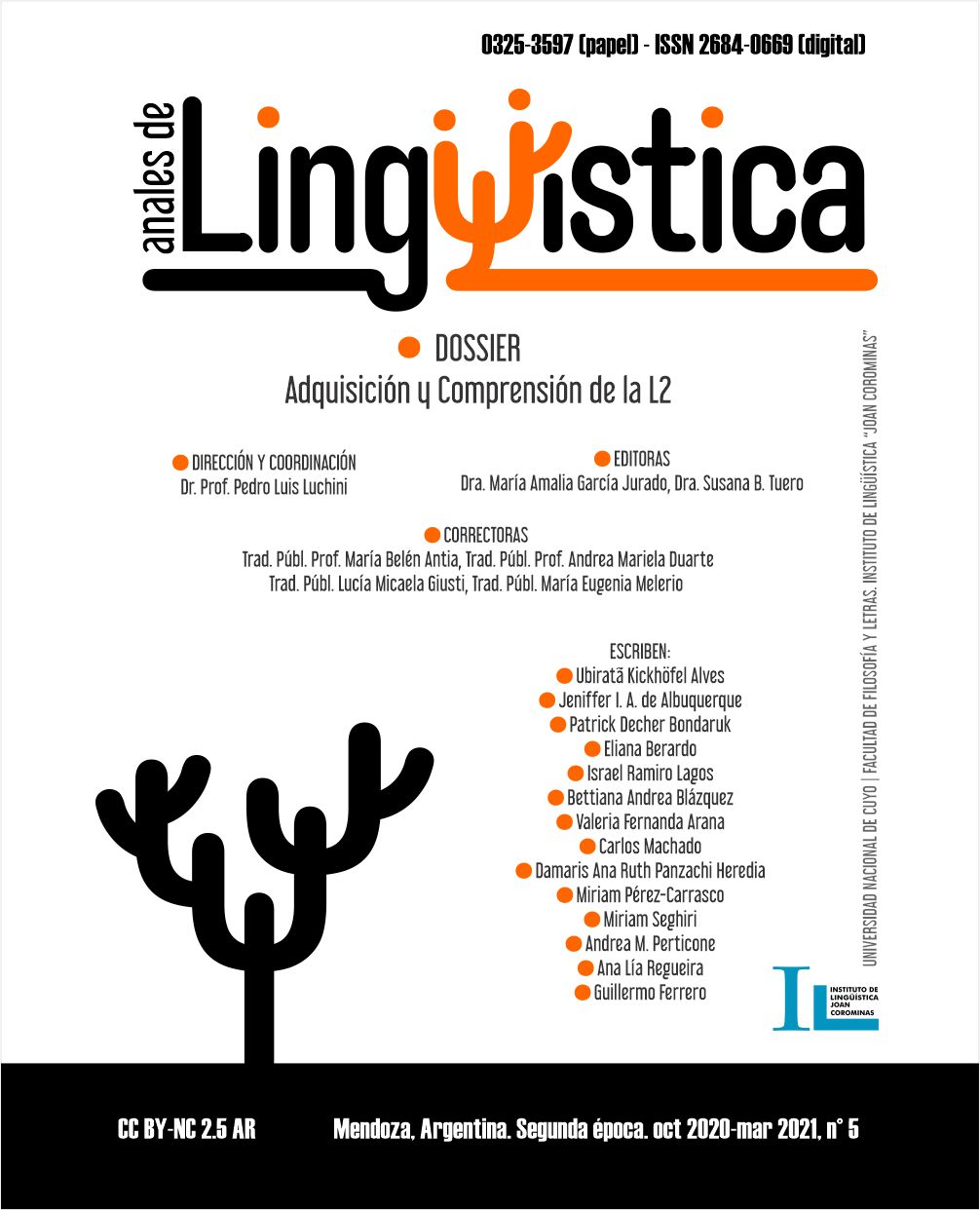Inteligibilidad y comprensibilidad en L2: puesta a prueba de nuevas mediciones con AEPI
Palabras clave:
Inteligibilidad, comprensibilidad, aplicación AEPI, tarea de repetición oral, medidas de tiempoResumen
En este artículo se presentan y analizan nuevos medios para verificar y medir los constructos de ‘inteligibilidad’ y ‘comprensibilidad’. Primeramente, presentamos una breve agenda de trabajos que contribuyeron con discusiones teóricas y empíricas sobre inteligibilidad y comprensibilidad (Munro & Derwing 1995; Munro & Derwing 2001; Derwing & Munro 2015; Munro & Derwing 2015; Nagle, Trofimovich & Bergeron 2019; Albuquerque 2019). Posteriormente, se presenta la aplicación AEPI (desarrollada por Bondaruk, Albuquerque y Alves 2018). Se trata de un programa de código abierto que no solo permite una medición más tradicional (tarea de transcripción) sino que también introduce nuevas variables a los estudios sobre inteligibilidad y comprensibilidad, al proporcionar una tarea de repetición oral y mediciones de tiempos de respuesta. Finalmente, se plantean y analizan el uso y las contribuciones de la aplicación AEPI a algunos trabajos de investigación (Alves, Albuquerque & Brisolara 2019; Salves, Wanglon & Alves 2020; Albuquerque & Alves 2020).
Citas
Albuquerque, J. I. A. y Alves, U. K. (2020). Os construtos de ‘inteligibilidade’ e ‘compreensibilidade’ em dados do Português Brasileiro como língua adicional: um olhar via Sistemas Dinâmicos Complexos. Signótica, 32. Retrieved from https://www.revistas.ufg.br/sig/article/view/58214
Alves, U. K., Albuquerque, J. I. A. y Brisolara, L. B. (2019). Pensando ‘Inteligibilidade da Fala em Língua Adicional’ sob uma concepção dinâmica e complexa: primeiros passos em direção a um novo ensino de pronúncia. En: A. M. Sousa, R. Garcia y T. C. Santos (Eds.). Perspectivas para o Ensino de Línguas – volume 3 (pp. 34-47). São Carlos: Pedro & João Editores.
Beckner, C. et al. (2009). Language is a Complex Adaptive System – Position Paper. Language Learning, 59 (1), pp. 1-26.
Bondaruk, P., Albuquerque, J. y Alves, U. (2018). AEPI - Aplicativo para Estudos de Percepção e Inteligibilidade. Versão 0.01. Disponible en: aepi.e-pi.co
Cruz, N. C. y Pereira, M. de A. (2006). Pronúncia de aprendizes brasileiros de inglês e inteligibilidade: um estudo com dois grupos de ouvintes. Revista Virtual de Estudos da Linguagem, 4 (7), pp. 1-26.
De Bot, K. (2017). Complexity Theory and Dynamic Systems Theory: same or different? In L. Ortega y Z. Han (Eds.). Complexity Theory and Language Development: in celebration of Diane Larsen-Freeman (pp. 51-58). Amsterdam: John Benjamins Publishing.
Derwing, T. y Munro, M. (2015). Pronunciation Fundamentals: Evidence-based perspective for L2 Teaching and Research. Amsterdam: John Benjamins Publishing.
Kang, O., Thomson, R. y Moran, M. (2018). Empirical approaches to measuring the intelligibility of different varieties of English in predicting listeners comprehension. Language Learning, 68 (1), pp. 115-146.
Lindemann, S. y Subtirelu, N. (2013). Reliably biased: The role of listener expectation in the perception of second language speech. Language Learning, 63 (3), pp. 567-594.
Lowie, W. y Verspoor, M. (2015). Variability and variation in Second Language Acquisition orders: a dynamic reevaluation. Language Learning, 65 (1), pp. 63-88.
Lowie, W. y Verspoor, M. (2019). Individual Differences and the Ergodicity Problem. Language Learning, 69, pp. 184-206. doi:10.1111/lang.12324
Munro, M. J. y Derwing, T. (1995). Foreign accent, comprehensibility and intelligibility in the speech of second language learners. Language Learning, 45, pp. 73-97.
Munro, M. J. y Derwing, T. (2001). Modeling perceptions of the accentedness and comprehensibility of L2 speech the role of speaking rate. Studies in Second Language Acquisition, 23 (4), pp. 451-468.
Munro, M. y Derwing, T. (2015). Intelligibility in Research and Practice: Teaching Priorities. En: M. Reed y J. Levis (Eds.). The Handbook of English Pronunciation (pp. 375-396). Blackwell.
Nagle, C.; Trofimovich, P. y Bergeron, A. (2019). Toward a dynamic view of second language comprehensibility. Studies in Second Language Acquisition, 41 (4), pp. 647-672.
Oliphant, T. E. (2007). Python for scientific computing. Computing in Science & Engineering, 9 (3), pp. 10-20.
Peirce, J. W. (2007). PsychoPy"”psychophysics software in Python. Journal of neuroscience methods, 162 (1-2), pp. 8-13.
Rato, A., Rauber, A., Kluge, D. C. y Santos, G. R. (2015). Design speech perception experiments with TP 3.1 Software. In: J. Mompean y J. González (Org.). Investigating English Pronunciation: Trends and directions. 1ed.Londres: Palgrave McMillan, 1, pp. 350-360.
Salves, D., Wanglon, P. & Alves, U. K. (2020). The role of L1 English speakers’ familiarity with Brazilian-accented English (L2) in the intelligibility of Brazilian leaners of English (L2): a discussion on intelligibility from a Complex, Dynamic Systems Perspective. Ilha do Desterro, 73 (1), pp. 339-362.
Zielinski, B. (2006). The intelligibility cocktail: An interaction between speaker and listener ingredients. Prospect: An Australian Journal of TESOL, 21 (1), pp. 22-45.
Descargas
Publicado
Cómo citar
Número
Sección
Licencia
Derechos de autor 2021 Anales de Lingüística
Esta obra está bajo una Licencia Creative Commons Atribución 2.5 Argentina.
Los/as autores/as que publican en esta revista están de acuerdo con los siguientes términos:
1. Los/as autores conservan los derechos de autor y garantizan a la revista el derecho de ser la primera publicación del trabajo bajo una licecncia Creative Commons Atribución 2.5 Argentina (CC BY 2.5 AR) . Por esto pueden compartir el trabajo con la referencia explícita de la publicación original en esta revista.
2. Anales de lingüística permite y anima a los autores a difundir la publicación realizada electrónicamente, a través de su enlace y/o de la versión postprint del archivo descargado de forma independiente.
3. Usted es libre de:
Compartir — copiar y redistribuir el material en cualquier medio o formato
Adaptar — remezclar, transformar y construir a partir del material para cualquier propósito, incluso comercialmente.























